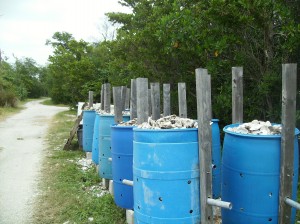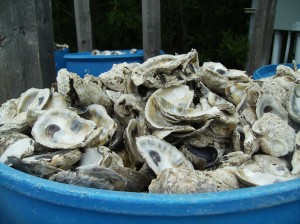11/30 Oysters On The Half Full Shell
During our stay in Stuart, Florida we visited the Florida Oceanographic Coastal Center. The Center is a marine life nature preserve created to encourage compassion and the environmental stewardship of Florida’s coastal ecosystems. We enjoyed a nature trail walk through the mangroves with our guide Bill. We walked and walked until we came to the Indian River Lagoon.
Bill took a few moments to share with us about the Oyster Restoration project. Due to fresh water overflow being discharged from Lake Okeechobee into the Indian River, the indigenous oyster population was dying off. In order to rebuild the oyster population, they began to re-introduce oyster larvae, which needs to attach a hard surface. At first they had little success, but soon discovered that the most ideal surface for growth are other oyster shells.
So, Bill told us that the Center began collecting discarded oyster shells from local restaurants and using them to create oyster shell reefs. According to The Center,” The shells are quarantined and then bagged by staff and volunteers and deployed to create new oyster-shell reefs in the Indian River Lagoon and St. Lucie River estuaries. Their progress is monitored using cutting-edge acoustic technology.”
I found the idea of resolving a dying population problem (created by unnatural means) by using a positive outcome from the consumption of Florida marine life incredibly empowering. They could have just said, “There is no way that we can even resolve this situation, especially coupled with the seafood consumption here, so we aren’t going to waste energy trying.” Instead they made a significant impact using what they had…..shells from oysters that had been commercially consumed. Interestingly ironic and imaginative.
The reality is that people consume lots and lots of seafood. At first, I found that very disheartening while in Florida because it is inescapable. I secretly wondered how I could possibly make an impact in an environment that believes it is a right and obligation to eat from our oceans. But visiting the Oceanographic Center and learning about the Oyster Restoration Project was the reminder I needed that I have the option of seeing the situation as half empty, a lost cause or half full, one that has possibility.
Every new decision and every action creates forward motion in a positive change. It isn’t about deciding to never eat meat or fish or dairy products again….it is about making new decisions at every meal not based on what all of your past decisions have been. So you usually have tuna or turkey cold cuts for lunch, tomorrow make a different choice for that day and you have made an impact. All of us making small choices that are creating great change and I think that is both empowering and exciting. Visiting The Oceanographic Coastal Center brought me back to that and I am grateful. We can allow what we see to overwhelm us into paralysis or we can be motivated to take action one step, one meal at a time.
Have a delicious day.
Tags: compassionate eating, Florida Oceanographic Coastal Center, going veg, Oyster restoration project, plant based diet, trying vegan, trying vegetarian, vegan, vegan challenge, vegan experience, vegetarian entertaining




December 3rd, 2011 at 5:47 am
You have in essence extracted a pearl of wisdom from an otherwise empty shell. Thank you for sharing your insight!
December 3rd, 2011 at 8:34 pm
Thank you Nik,
I thought what they’re were doing was brilliant and so incredibly pro-active. Sure, we can just give up based on what we see or we can start where we are with what we have and make something happen.